Ninety-three years later
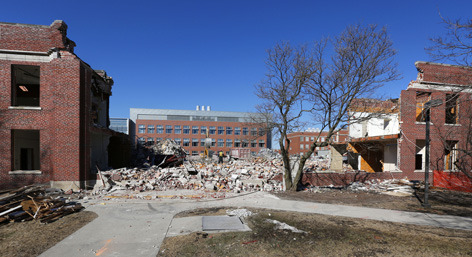
March 10: Davidson Hall site, looking north at Hach Hall.
Crews made great progress over spring break dismantling the 93-year-old Davidson Hall on Osborne Drive, former home of the agricultural and biosystems engineering department. Less than two weeks lapsed between the photos (above and below). Much of the building -- both its contents and its exterior -- have been repurposed or recycled.
The ISU student chapter of the American Society of Agricultural and Biological Engineers is selling Davidson Hall bricks as a chapter fundraiser this spring. Orders may be placed online.
The temporary plan for the site is as a parking lot until university leaders identify another need. Photos by Christopher Gannon.
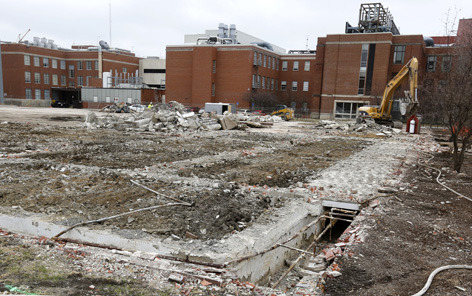
March 23: Former Davidson Hall site, looking east toward Gilman (right) and Spedding (left) halls.
Beth McNeil named library dean
Beth McNeil, professor and associate dean for academic affairs at the Purdue University Libraries, West Lafayette, Indiana, has been named dean of the Iowa State University Library. She will begin on July 15.

Beth McNeil
"Iowa State's libraries are a tremendous asset, not only for the university, but for all Iowans," President Steven Leath said. "Beth McNeil's leadership will help take our programs to the next level, broaden the resources available to students and faculty, and expand the reach of our scholarship."
At Purdue, McNeil was responsible for managing 12 campus libraries, as well as the archives/special collections, technical services, digitization and the collections management units. She had oversight of nearly 90 faculty and staff and a $13.7 million annual collections budget.
McNeil previously served in leadership positions in the libraries at Bradley University, Peoria, Illinois; and University of Nebraska, Lincoln.
"I am honored to serve Iowa State as dean," McNeil said. "It's a great library with an exceptional history and a bright future. I look forward to working with students, faculty and staff to support our mission to create, share and apply knowledge in Iowa and around the world."
Iowa State's library serves the entire campus with a $23 million budget and 110 faculty and staff. The library includes:
- Parks Library, which houses the main collections, library services and digital repository
- Veterinary medicine library
- Subject-based reading rooms for design and mathematics
Parks Library recently ranked 16th among The 50 Most Amazing College Libraries by CollegeRank.net.
McNeil earned a bachelor's degree in English and a master's degree in library and information science, both from the University of Illinois, Urbana-Champaign. She completed a doctoral program in human sciences, with a focus on leadership studies, at Nebraska.
In making the announcement, senior vice president and provost Jonathan Wickert praised interim dean Joyce Garnett for her leadership and members of the search committee for their thoughtful consideration of candidates.
Hansen building earns LEED Gold
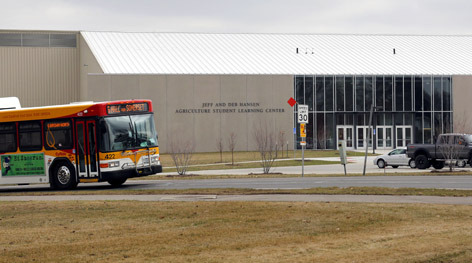
The Hansen Agriculture Student Learning Center on Mortensen Road scored points for "community connectivity" -- including easy access to public transportation -- in the LEED building certification process. Photo by Christopher Gannon.
Iowa State has captured its ninth LEED certification in eight years for green construction or building renovation. Earlier this month, the Jeff and Deb Hansen Agriculture Student Learning Center received Gold certification, which is second only to Platinum in the LEED (Leadership in Energy and Environmental Design) green building rating system.
The U.S. Green Building Council launched LEED in 1998 to measure environmentally sensitive building design, construction, operations and maintenance. The standards in this voluntary program have become more stringent as it evolved.
Iowa State's LEED-certified projects
Platinum: College of Design King Pavilion (2010), State Gym (2012)
Gold: Biorenewables Research Laboratory (2011), Hach Hall (2011), Small Animal Hospital at the Lloyd Veterinary Medicine Center (2013), Troxel Hall (2014), Hansen Agriculture Student Learning Center (2015)
Silver: Morrill Hall (2008), Bergstrom Football Complex (2014)
In certification process: Curtiss Hall renovations (2), Sukup and Elings halls
In construction: Marston Hall renovation
During that time, state and city building codes likewise have raised the bar in defense of the environment, as have construction-related businesses.
"This is becoming the way companies do business, so the LEED certification process isn't about spending more, it's just a little more [labor] and paperwork," said Kerry Dixon, coordinator for sustainable design and construction in facilities planning and management.
For example, Dixon said the steel industry prefers to recycle metal (it costs less than mining new ore) and concrete companies such as Iowa-based Manatt's are using a lot of recycled content in their concrete. At the same time, by recycling what once was handled as construction waste, ISU cuts back on fees it pays to the Boone County demolition landfill.
Highlights of the Hansen center
The Hansen facility features four finished classrooms (with space for two more), restrooms, serving kitchen and an indoor arena that measures 250 feet by 110 feet and has 825 permanent seats.
LEED measures achievements in five categories plus an innovation category (for exemplary performance in any of the five) and awards a credit total. The Hansen center scored a 63 on the LEED 110-credit scorecard. The university applied for 71 credits.
Highlights of the building's design and performance are:
- A geothermal heating and cooling system (partially paid for with an ISU Live Green! loan) contributes to energy consumption that is 33 percent better than state code
- Low-flow sink faucets, toilets and urinals reduce potable water use 43 percent
- Paints, flooring, adhesives and sealants used in the building emit no or low levels of toxins
- 41 percent of building materials, by value, were extracted from the earth or manufactured within 500 miles of Ames
- 26 percent of building materials, by value, contain recycled materials
- 60 percent of the construction waste generated at the site was recycled
- "Super white" concrete in the parking lots reflects sunlight and is 10 percent cooler than standard concrete (reducing the "heat island" effect)
- A half dozen premium parking stalls are reserved for fuel-efficient or low fuel-emission vehicles
- Two CyRide bus routes serve the site
- Site landscaping doesn't require/use a permanent irrigation system
- The custodial plan, products and equipment comply with LEED's green cleaning policy
Art conservator's services are always on the house
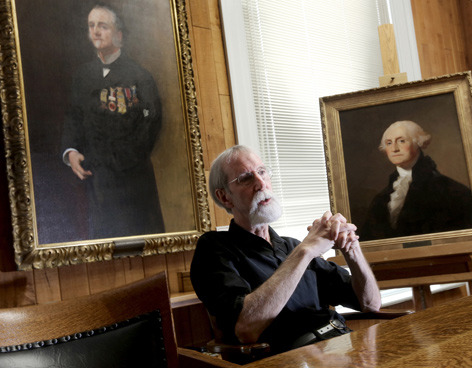
Bauman is flanked by two recently conserved paintings for other institutions -- John Singer Sargent's "Lucius Fairchild" and Thomas Sully's "George Washington." Contributed photo.
It seems too good to be true -- a rock star in the world of art conservation offering to restore old paintings for Iowa State, other universities and museums, for free. Believe it. Over the past decade, Illinois conservator Barry Bauman has restored more than 1,500 paintings for nonprofit groups.
To take advantage of Bauman's expertise, institutions simply need to ask. So far, Iowa State has asked 19 times.
Deal of the century
"It's just an unbelievable offer that, for the negligible cost of materials, Barry will conserve your work of art," university museums director Lynette Pohlman said. "It's the deal of the century."
Pohlman estimates that deal so far has saved Iowa State approximately $75,000 in conservation fees and put some very nice paintings back on display.
Old paintings come back from Bauman's in-home studio in beautiful condition, Pohlman said.
A recent restoration of a small 19th century painting of ducks in a farm house "just glows," she said. "For the first time, you really see it as the artist intended."
Bauman's restorations hang in many universities, museums, schools and historical facilities throughout Iowa and the Midwest, Oklahoma, Kentucky, Tennessee, Maryland and Arizona.
"Barry understands that works of art, whether significant to Iowa or to the world, need preserving," Pohlman said. "This is his way of encouraging America's cultural heritage."
Entrepreneur to pro bono
An elected Fellow of the American Institute for Conservation, Bauman worked for the Art Institute of Chicago for 11 years. He was the institute's associate conservator of painting when he left in 1983 to found the Chicago Conservation Center. Over the years, the center's focus expanded from conservation of paintings to conservation of all kinds of art, and it's now the largest conservation laboratory in the country.
Master conservator, sleuth
While cleaning a painting in 2011, Bauman discovered that a legendary painting of Mary Lincoln was a sham. New York Times story.
In 2003, Bauman sold the company, and shortly thereafter, launched Barry Bauman Conservation, a one-man effort to provide pro bono conservation services to museums and nonprofit organizations. Bauman has been at this latest endeavor for a decade and shows no signs of stopping.
"Sometimes you hear people say, 'I love my work so much I'd do it for free,'" Bauman explained. "How many people do you know who do that? I know one. That's the way it's always been for me. I've always just loved what I do. I do it because it brings me great rewards and it gives me an opportunity to help museums that can't pay for the lights and heat."
Bring more
And so 10 months of the year, Bauman can be found at home in Illinois, cleaning, repairing and retouching old paintings for the likes of the Phoenix Art Museum, the Wisconsin Historical Society in Madison, Starved Rock State Park, Illinois, and Iowa State. The other two months, you'll find him in New Zealand, taking a rest from the brushes, solvents and Chicago winters.
Allison Sheridan, university museums program coordinator, often gets the call when Bauman has finished a project for Iowa State.
"Every time he calls," she said, "he says, 'Your paintings are ready. Come pick them up and bring more.'"
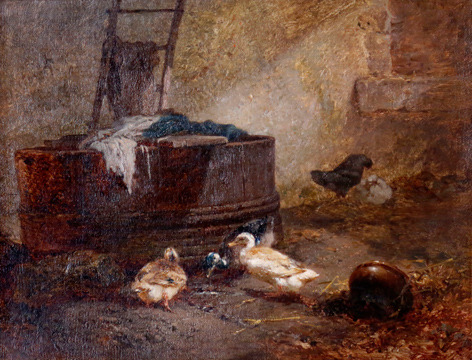
Bauman's recent restoration for Iowa State -- "Ducks," c. 1841, by V. Monselm -- "just glows," said museums director Lynette Pohlman. The 15-by-18 inch oil on canvas is on display in Farm House Museum. Photo by Christopher Gannon.
CELT symposium offers ways to recharge your teaching
Whether you’re a seasoned scholar or a new faculty member just starting out, consider attending the Center for Excellence in Learning and Teaching (CELT) Morrill Professor Panel and Teaching Poster Symposium on March 30 (3-4:30 p.m., Memorial Union, Campanile Room).
Attendees will have a chance to browse approximately 30 poster displays showcasing the results of the CELT Teaching Partners and the Center for the Integration of Research, Teaching and Learning (CIRTL) programs. Poster topics address various philosophies of learning and teaching techniques, including the results of team-based learning and test anxiety experiments. The Teaching Partners program pairs a senior faculty member with a group of two or three junior faculty members who work together on a particular teaching strategy or concern. CIRTL, a professional development program for graduate students and post-docs, aims to improve science, technology, engineering and mathematics (STEM) learning of all students at every college and university, increasing the nation's STEM literacy.
At 3:30 p.m., the 2014 Morrill Professors will speak about how teaching has impacted their lives, students and disciplines. The Morrill Professorship, first awarded in 2013, recognizes faculty members with outstanding success in teaching and learning in undergraduate, graduate or extension/outreach programs. The speakers are:
- Cinzia Cervato, Morrill Professor of Geologic and Atmospheric Sciences
- Robert Stephenson, Morrill Professor of Statistics
- Donald Simonson, Morrill Professor of Music
All faculty, graduate students and post-docs are welcome to attend. No registration is required. Refreshments will be served.
Art-inspired flower power
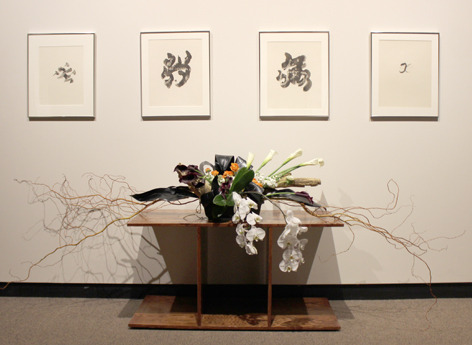
This 2014 arrangement, "Hatsuboku" by Reiman Gardens staff, was inspired by artist Ulfert Wilke's "One, Two and More." Contributed photo.
The Brunnier Art Museum celebrates its seventh annual Brunnier in Bloom this weekend, March 27-29. The event -- a marriage of art and flowers -- kicks off with a Flowers After Hours reception on Friday (6-8 p.m.) to reveal this year's winners. Visitors can meet the floral artists and enjoy live music, cupcakes and a cash bar.
The weekend showcase of entries, which runs 11 a.m. to 4 p.m. both days in the Scheman Center's Brunnier Art Museum, includes daily youth crafts, a presentation on native Iowa plants (1 p.m. Saturday), a raffle and a silent auction. Visitors can cast their ballot for the People's Choice award. The event is free and open to the public.
